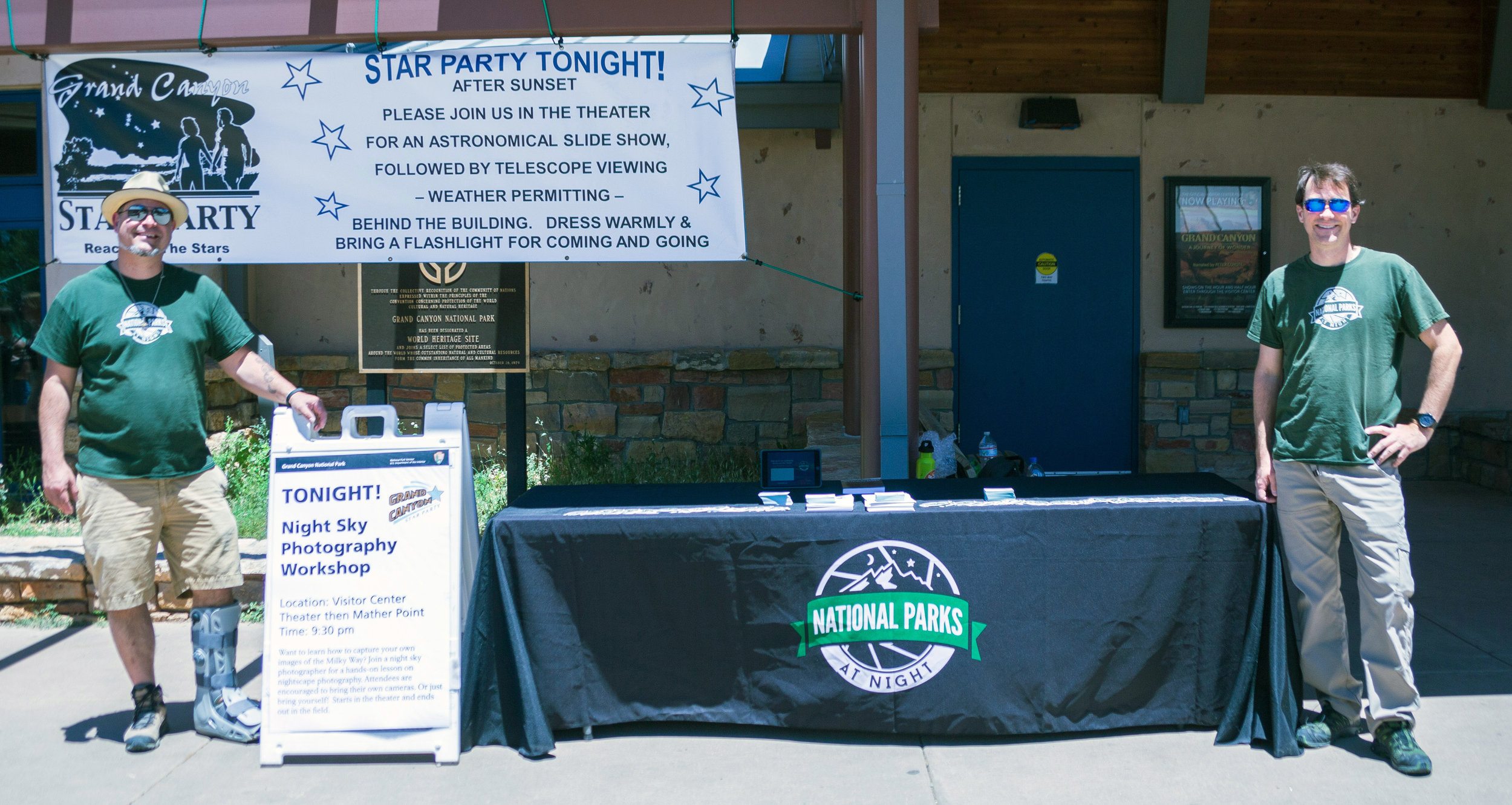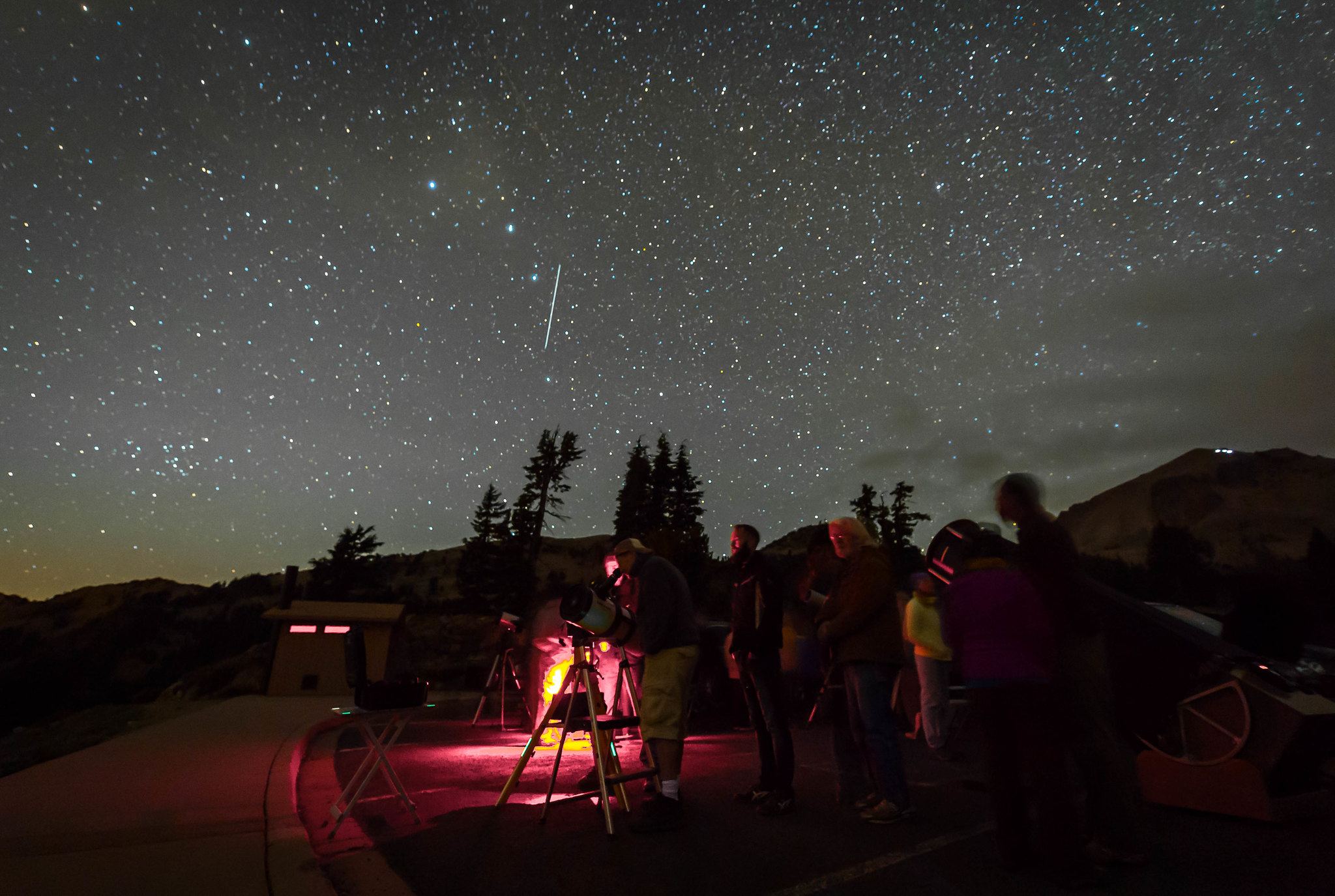One of the things I love about my job is that I get to experience so much of what our national parks offer. From soul-easing sunrises to serene night skies, from windswept desert landscapes to alpine lakes and streams—I get to see it all and reconnect with the natural beauty we were all born from eons ago.
In addition to all the wilderness it preserves, the institution of the National Park Service offers countless opportunities to engage with these places and to interact with others who enjoy them so passionately. One such opportunity is the Grand Canyon Star Party, the annual festival of night at one of the world’s most famous natural spaces. And last week, National Parks at Night was fortunate and proud to be a part of this stellar event.
A Grand Party
Many national parks organize night sky festivals, but the Grand Canyon puts on one of the biggest. The party lasts eight days—long enough for us to participate last weekend, come home, write a blog post, and share the news with you today while the event is still going on.
Photographing the Milky Way at Mather Point. © 2019 Gabriel Biderman.
Ten thousand night sky fans were expected to visit the park this week specifically for the festival, and scores more serendipitously joined the activities when they happened to find themselves in the right place at definitely the right time. Those folks enjoyed (and today are still enjoying):
lectures about dark skies, astronomy and nocturnal activities
more than 50 telescopes available for viewing planets and galaxies, arranged by the Tucson Amateur Astronomy Association
ranger-led constellation walks
a general camaraderie among like-minded knights of the night
This year marked the 29th Star Party, and the biggest news of the event (no, it wasn’t that we were there) was this:
On the very first morning the International Dark Sky Association visited to certify the Grand Canyon as an International Dark Sky Park—the 70th and now the largest park of its kind in the world. It’s an honor that took three years for the park to earn, partly by converting over 5,000 lights to be dark-sky compliant—creating what Forbes Magazine recently dubbed “the $1 million Milky Way.” The retrofitting funds were raised by the Grand Canyon Conservancy, the park’s nonprofit partner.
Introducing: Night Photography!
What was our place in all of this? For two days Gabriel Biderman and I led education about—you guessed it!—night photography. According to the rangers we worked with, this is the first time the festival has offered a night photography component, and we were thrilled to lead the way.
The Grand Canyon Star Party is broken into two halves—one on the South Rim, one on the North. We were stationed at the former, working around the primary visitor center.
On our first night, we delivered a presentation titled “Night Photography in the National Parks.” The visitor center theater accommodates 233 people, and every chair was occupied. Moreover, we learned afterward that about 325 people were outside the theater watching the large-screen livestream of the talk—for a total of about 550 attendees! That fully reinforced how big an event we were part of. I can’t speak for Gabe, but I know it’s the largest audience I’ve ever spoken to. I’m not sure I could adequately describe how fulfilling it is to be able to share a passion with so many.
Gabe and I posing with our in-house audience.
The talk centered around—well, the title says it all. We relayed some of the experiences of the Grand Canyon South Rim workshop that we had just wrapped up a few days before, showing images that we’d created of the canyon under moonlight, in addition to some behind-the-scenes pictures of our workshop attendees enjoying the night. And then we spent half an hour showing our photographs from 29 national parks—from Acadia and Arches to Yellowstone and Zion—sharing stories about the experience of being in these wonderful places at night.
When the talk was over, we signed some books in the back. We usually sell books on our own at events like this, but the Grand Canyon Conservancy asked if they could make the sales. We were more than happy to have them take over. They do great work, and we’re on board with any way we can support them. (If you have a love of, or an interest in, the Grand Canyon, check out what they do at the link above.)
© 2019 Cindy Radich.
Then we met with 60 photographers who were on hand for the free night-photo walk we were leading. Everyone gathered in the theater, where Gabe and I walked them through setting up their cameras for night photography. Then we all walked under the night sky to Mather Point, one of the most stunning vistas in the park and the best spot on the South Rim to view the Milky Way. Everyone was able to create some great images of our galactic core rising over the rim—many of them for the first time! The smiles were so big that we could see them even in the dark.
Day Work
The next day we were up early (well, early for us) so we could set up our table at the festival. The park was kind enough to station us right outside the main visitor center, in the heart of the goings-on. We spent the afternoon (a beautiful, sunny, cloudless, blue-sky day) meeting and greeting fellow photographers and night enthusiasts, talking about the Grand Canyon and other parks, sharing info about our workshop program, and giving out a lot of NPAN stickers to kids and kids-at-heart.
Photo © 2019 Jen Bookman.
Gabe and I with our hard-earned Junior Ranger Night Explorer patches.
(Funny story: We were stationed so much in the middle of the activity that people kept asking us for general information about the Star Party—what it was, where to be for events, and so on. We were happy to oblige. Late in the day a ranger noted how helpful we’d been, and he thereby awarded us Junior Ranger patches.)
On that second night we led another photo walk, exactly the same as the previous night’s, except this time about 70 photographers partook. Many of them were people we’d met and chatted with during the day—lots of new friends and smiling faces.
One notable difference between the first- and second-night groups was that more than several of the latter hadn’t come to the festival with the intent of photographing at night, and thus didn’t have tripods. Fortunately for us, Manfrotto has treated us well over the past couple of years, so we had a few extra tripods we could loan out—all from the Traveler series.
Even more than the previous night, people were walking away from Mather Point with the first Milky Way images they’d ever created. And some went even further. One attendee tried his very first Milky Way pano, a couple of more decided to venture into star trails for the first time, and the last photographer standing that night, by the time Gabe and I left, was well into his inaugural run at making a Milky Way time-lapse.
Winding Down
At the end of the two days, Gabe and I were simultaneously wiped out and reinvigorated. Neither of us had ever been involved with an event quite like this, and now we can hardly wait to be involved in one again. We could feel two communities coming together—introducing our night photography community to astronomers and avid stargazers, and likewise enjoying being embraced by them in return.
There are so, so many people who love to soothe their souls with sunrises, desert landscapes, and alpine lakes and streams—and who love to seize the night. And now we’re lucky to be friends with more of them.
Notes
We owed, and conveyed, gratitude to several people for helping us make this happen. But three we’d like to mention here:
Thank you to Rader Lane, the ranger who brought us into the fold and served as our point person on-site. He also spent his morning off from work saving my laptop. Upon leaving the park I left my bag behind in the house. Rader retrieved it and ensured that it found its way to FedEx. If not for him, I wouldn’t have been able to write this post—in more ways than one.
Thank you to Jen Bookman and Cindy Radich, two of our Grand Canyon workshop attendees who stayed for the Star Party and shared their photos with us for this post. It was nice to have personal photographers on hand, and we always enjoy their company.

















